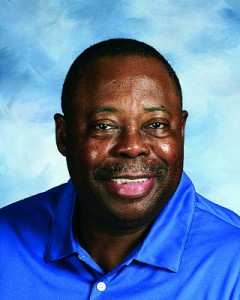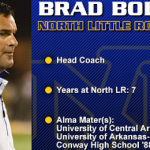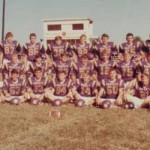Many Changes in Arkansas High School Football
The original version of this story ran in the September issue of Celebrate Arkansas magazine. It is reprinted with the permission of Celebrate Arkansas.
 In 1968, Wadie Moore Jr. began working as a sportswriter for the Arkansas Gazette. High school football was a much different sport then than it is now. For one thing, segregation was just starting to end across the state. Towns in east, central and south Arkansas that long had had a black high school playing football and a separate white high school playing football were fielding their first integrated teams.
In 1968, Wadie Moore Jr. began working as a sportswriter for the Arkansas Gazette. High school football was a much different sport then than it is now. For one thing, segregation was just starting to end across the state. Towns in east, central and south Arkansas that long had had a black high school playing football and a separate white high school playing football were fielding their first integrated teams.
Moore would remain at the Gazette until it ceased publication in October 1991. For years, he was the go-to media source for everything having to do with high school football in Arkansas. His weekly predictions and rankings were anxiously awaited by players and their parents across the state.
The changes Moore has seen since 1968 go beyond integration.
“The equipment is far better now than when I started covering sports in 1968,” says Moore, who now helps oversee high school football in the state as the assistant executive director of the Arkansas Activities Association. “I recently looked at some football gear and actually wondered for a moment how to put it on. There have been a lot of changes and there will continue to be equipment changes for safety reasons. The biggest equipment change has been in the design of the helmet.
“Another major change is officiating. Officials are more knowledgeable these days because of their desire to move up in the ranks. Arkansas has its fair share of officials working on the professional and college levels. Most of them got their start working high school football games. They became students of the game. The majority of today’s officials also are in excellent shape.”
move up in the ranks. Arkansas has its fair share of officials working on the professional and college levels. Most of them got their start working high school football games. They became students of the game. The majority of today’s officials also are in excellent shape.”
By the 1972 football season, with integration almost complete, there were five classifications in Arkansas high school sports. The largest was Class 4A. Its members were North Little Rock Ole Main, North Little Rock Northeast, Little Rock Hall, Little Rock Catholic, Little Rock Central, El Dorado, Fort Smith Northside, Pine Bluff and Little Rock Parkview. There were no schools in the northwest corner of the state in that largest classification in 1972.
Class 3A consisted of two eight-team conferences. Then there were Class 2A, Class A and Class B. There were 184 schools playing football in 1972. Among the football teams in 1972 that are no longer around were North Little Rock Northeast, Fort Smith St. Anne’s Academy, Hughes, Altheimer, Eudora, Cotton Plant, Rector, Holly Grove, Lewisville, Delta, Grady, Gould, DeValls Bluff, Arkansas School for the Deaf, Altus, Gillett, Wabbaseka, Bradley and Glenwood.
There are now seven high school athletic classifications with football played in six of them. The state has 211 schools that field football teams. Current football teams that weren’t around in 1972 include Rogers Heritage, Springdale Har-Ber, Little Rock Christian, Shiloh Christian in Springdale, Brookland, Cave City, Arkansas Baptist in Little Rock, Central Arkansas Christian in North Little Rock, Melbourne, Episcopal Collegiate in Little Rock, Riverview, Cedarville, Centerpoint, Fountain Lake, Cedar Ridge, Hackett, Hartford, Hector, Magazine, Union Christian Academy in Fort Smith, Western Yell County, Westside Johnson County, Bigelow, Conway Christian, Cutter Morning Star, Jessieville, Two Rivers, Poyen, Quitman, Palestine-Wheatley, Spring Hill, Parkers Chapel and Woodlawn.
With websites, blogs, magazines, television programs, radio shows and more dedicated to the sport, the interest in Arkansas high school football is greater than ever before. The staff at Little Rock’s War Memorial Stadium now considers the two December weekends when the six state championship games are played – three games are played one weekend and three games are played the next weekend – to be the stadium’s signature events along with the two University of Arkansas home games that are played in Little Rock.
The high school football season often is referred to as the Road to the Rock.
“Hosting the state championship football games is a great privilege for us and a highlight of our schedule of events,” says Little Rock attorney Kevin Crass, the chairman of the War Memorial Stadium Commission. “Every team in the state begins the season with the goal of getting to the Rock. It’s fun to watch as champions are crowned and memories are made.”
There has been a distinct shift in the center of gravity from the Little Rock area to Northwest Arkansas when it comes to the most powerful programs.
Robert Yates began working part time at the Arkansas Democrat in 1983. He became a full-time employee of the newspaper in 1985 and has continued to work as the lead high school football writer for the Arkansas Democrat-Gazette. Yates has had a front-row seat for three decades to watch that geographic shift.
“Because of explosive growth in Northwest Arkansas, Bentonville, Fayetteville and Springdale Har-Ber are now what Little Rock Central, Little Rock Parkview and Little Rock Hall were in, say, 1980,” he says. “Bentonville, for example, was the smallest school in the state’s largest classification in the late 1980s and early 1990s with 751 students in the 1991-93 cycle used by the Arkansas Activities Association. Bentonville was so small compared to the other schools in the largest classification that it played as an independent in 1989 and 1990 rather than compete in the then-4A-West. Now, Bentonville will be the state’s largest school for the third consecutive cycle in 2014-16 with 2,877 students based on the Arkansas Activities Association figures that are used to classify the state’s 16 largest schools.”
Yates says high schools in Northwest Arkansas have taken full advantage of the region’s growth.
“The Class 7A-West, in particular, is like a high school version of the Southeastern Conference with schools building the best facilities, having the largest coaching staffs and the biggest rosters. Northwest Arkansas schools were also ahead of the competition in their style of play with wide-open spread schemes on offense and progressive thinking.”
The Northwest Arkansas high schools further outpaced the competition with the facilities they built, the coaches they hired and the things they did during the offseason.
Yates gives a few examples: “In 2001, Springdale became the first school in the state to play on artificial turf at an on-campus venue. Team camps are the rage across Arkansas during the summer these days, but a handful of schools in Northwest Arkansas were traveling to Tulsa for team camps by 2000 and facing national powers such as Tulsa Union and Jenks, Okla.
“Greenwood wanted a topnotch football program when it hired Rick Jones in January 2004. He doesn’t teach any classes, but the school has certainly gotten what it paid for. He has a 107-16 record going into this season, seven conference championships, six state championships and a 38-game winning streak entering the 2013 season. Barry Lunney has a similar setup at Bentonville, which has won two state championships since 2008 and has won 35 consecutive regular-season games since 2009.”
Yates points out that Bentonville had the worst facilities in Class 7A-West before Lunney arrived in 2005. Then, the school built its athletic complex.
“It looks like something on a college campus,” Yates says. “What will be interesting to follow in the coming years is how well smaller public schools in Northwest Arkansas compete on a statewide level. Programs like Farmington, Gravette, Prairie Grove and Pea Ridge in Class 4A have made noise in recent seasons and probably will continue to flourish as more families move to Northwest Arkansas. Those schools also are positioned to scoop up players who transfer for one reason or another from schools in Fayetteville, Rogers and Springdale.”
 Pea Ridge moved into the 45,166-square-foot Blackhawk Multi-Purpose Facility in the fall of 2011 and will play in a new stadium this fall. The indoor facility at Pea Ridge includes a 65-yard field, a 6,600-square-foot weight room, three locker rooms, a training room, a video room and offices for the coaches. The new Blackhawk Stadium will feature an artificial playing surface.
Pea Ridge moved into the 45,166-square-foot Blackhawk Multi-Purpose Facility in the fall of 2011 and will play in a new stadium this fall. The indoor facility at Pea Ridge includes a 65-yard field, a 6,600-square-foot weight room, three locker rooms, a training room, a video room and offices for the coaches. The new Blackhawk Stadium will feature an artificial playing surface.
“Who would have imagined in 1980 that Pea Ridge would have better facilities than Little Rock Central, Little Rock Parkview and Little Rock Hall?” Yates says.
Down in the southwest corner of the state, Jay Bunyard has called 287 consecutive live games on KDQN radio for the De Queen High School Leopards. That streak dates back to the 1987 season. Prior to that, Bunyard called numerous games on a tape-delayed basis. He now owns radio stations across the state. His radio group will air the games of 12 high school football teams this year, including Bentonville (99.5 FM), Shiloh Christian (105.3 FM), Berryville (107.1 FM) and Green Forest (1480 AM). Like Moore and Yates, Bunyard has watched the game change drastically.
“The major changes I’ve noticed through the years are the style of play, better safety precautions for athletes, longer travel to road games and the fact that football has become a year-round sport,” Bunyard says. “When I first started broadcasting games, I can remember the late Coach Wayne Freppon at De Queen and the late Coach Lonnie Barron at Mena playing 48 minutes of field-position football. They were very conservative when it came to calling plays, waiting for the other team to make a mistake. You might see a 0-0 tie or a final score of 3-0 or 7-0. Teams now spread the field and try to get the ball into the hands of their best athletes at wide receiver. De Queen and Mena combined for 57 points last year. It’s not uncommon these days to see a team score 60 or even 70 points in a high school football game.”
As for the safety of the game, Bunyard says it had to change because “athletes are now bigger, stronger and faster. Collisions are more violent. But the helmets, pads and equipment are significantly improved. Major penalties are now called for leading with the helmet and horse-collar tackles. Coaches receive extensive training on hydration and how to spot problems in the extreme Arkansas heat.”
Finally, there’s the travel and the year-round nature of the sport.
“I can’t remember traveling more than 90 minutes for a regular-season game years ago,” Bunyard says. “That was good for the fans, and it was good for the players. It created some great rivalries. Last year, I drove three hours one way for conference games on two occasions. I’m not sure what the answer is, but it’s certainly something that the Arkansas Activities Association should study.
“Football is no longer just a fall sport. There’s spring practice along with summer team camps and seven-on-seven games during the summer. I don’t know that this is necessarily a bad thing. It seems to be resulting in better college recruits coming out of Arkansas. But it does require more of a commitment from the players and their parents.”
Journalist Nate Olson moved to Arkansas in 1998. He was the sports editor of the Pine Bluff Commercial for more than five years, edited the high school sports magazine Vype in central Arkansas and now edits the weekly publication Sync.
“The talent pool has increased considerably since I arrived in Arkansas,” Olson says. “There were only a handful of Division I players that first season I was here, and the University of Arkansas only recruited a few of them. The state is now among the top 10 in the nation per capita in producing Division I football players. I credit spring football and seven-on-seven football for that change.
“The mindset about football has changed in this state. It was almost as if the administrators got together and decided that they wanted the state to be on par with the high school football that was being played in Louisiana and Texas. We still have a long way to go to reach that level, but Arkansas has made a name for itself with more high-profile recruits and nationally ranked programs. Administrators have invested in new facilities and paid the top coaches well. Those investments have paid off.”
Down in De Queen, Bunyard says the one thing that hasn’t changed about high school football is the passion of the fans. It’s just that there are now more of those fans.
“Surveys show that more than 250,000 Arkansans will attend high school football games on Friday nights this fall,” he says. “Rivalries that date back more than 100 years are now more intense than ever. There’s still nothing better than high school football.”











